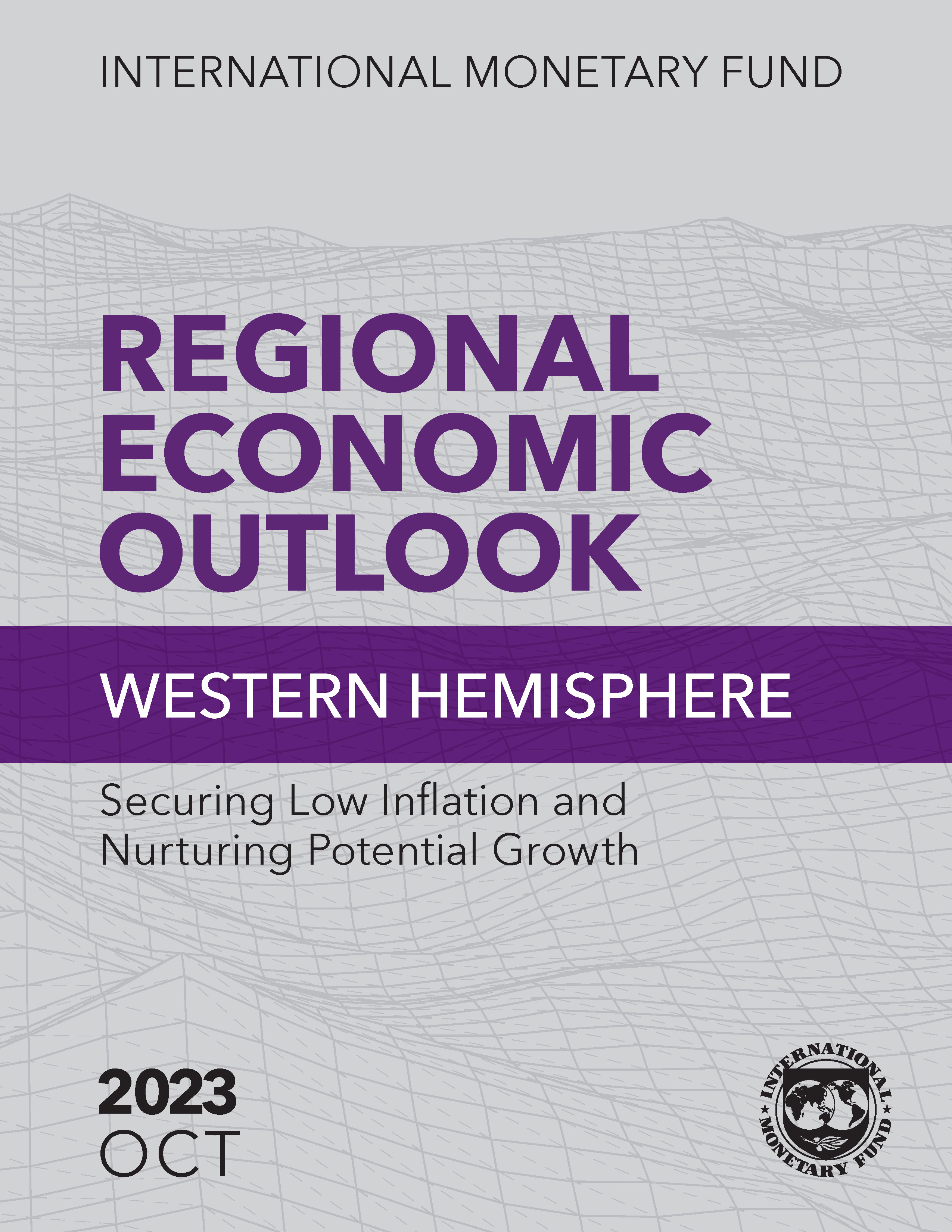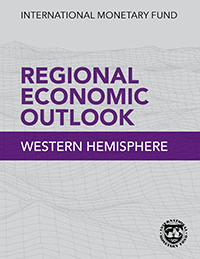Western Hemisphere Region
2024
April 19, 2024
Regional Economic Outlook, Western Hemisphere, April 19th, 2024
Description: The Latin America and the Caribbean region has shown remarkable resilience in the face of recent global challenges, rebounding more strongly than expected from the pandemic. Growth is now moderating, from 2.3% in 2023 to 2.0% in 2024, as most economies are operating at potential. This moderation is also due to a weaker external environment and the ongoing impact of tight policies aimed at curbing inflation.
2023
October 13, 2023
Regional Economic Outlook: Western Hemisphere, October 2023
Description:
Securing Low Inflation and Nurturing Potential Growth After a stronger-than-expected recovery from the pandemic and continued resilience in early 2023, economic growth in Latin America and the Caribbean (LAC) is softening as the effect of tighter policies to combat inflation is taking hold and the external environment is weakening. The early and swift monetary tightening across the region since 2021, together with the withdrawal of most of the pandemic fiscal stimulus and the reversal of external price pressures, have helped put headline inflation on a downward trajectory. Core inflation has also started to ease, as price pressures are becoming less generalized, although it remains elevated amid strong labor markets and positive output gaps in some countries. Banking systems have weathered the rise in interest rates well and are generally healthy, though credit to the private sector is decelerating amid tighter supply conditions and weaker demand.
April 13, 2023
Regional Economic Outlook for the Western Hemisphere, April 2023
Description:
In Latin America, fiscal policy can lighten the burden of central banks Growth in Latin America is projected to slow to 1.6 percent this year after a remarkable 4 percent in 2022. Price pressures that accompanied last year’s brisk economic activity appear to have peaked, but underlying inflation remains stubbornly high, disproportionally hurting low-income households who spend most of their earnings on food. To mitigate the risk that inflation becomes entrenched, fiscal policy can help monetary policy in reducing demand pressures. After peaking at 10 percent in mid-2022, headline inflation in the largest Latin American economies has slowed to 7 percent in March. However, this drop mostly reflects the fall of commodity prices from their peaks. Progress in bringing down core inflation, which excludes food and energy, appears to have stalled. Labor markets are tight, with employment firmly above its pre-pandemic levels. At the same time, output is at or above potential, and short-term inflation expectations exceed central banks’ target ranges. Strong domestic demand, rapid wage increases, and broad-based price pressures all point to a risk that inflation in the region could remain unacceptably high.
2022
October 13, 2022
Regional Economic Outlook for the Western Hemisphere, October 2022
Description:
Navigating Tighter Global Financial Conditions Recent developments in the Western Hemisphere—that is, the United States/Canada and Latin America and the Caribbean (LAC)—have been dominated by the impact of two distinct global shocks: the COVID-19 pandemic and then the Russian invasion of Ukraine. A third shock—the tightening of financial conditions—is now shaping the outlook. After contracting sharply in 2020, most of the Western Hemisphere’ economies recovered strongly in 2021 and early 2022, helped by the global recovery, the normalization of service sectors, and booming commodity prices. However, inflation pressures built up with pandemic-related disruptions, expansionary policies, rebounding demand, and the impact of the war in Ukraine on energy and food prices. The swift response of LAC’s monetary authorities to rising inflation—well ahead of other economies—helped contain price pressures and keep long-term inflation expectations anchored, but inflation remains high. Amid global monetary and financial tightening, and the ensuing slowdown in global growth and softening of commodity prices, activity is expected to decelerate throughout the Western Hemisphere in late 2022 and 2023, while inflation pressures are expected to recede gradually. Downside risks dominate the outlook and stem from tighter financial conditions, a more pronounced global slowdown, and entrenched inflation. For LAC, a sharp fall in commodity prices and social unrest are important risks. With inflation yet to abate and most economies still operating at or near potential, monetary policy should avoid easing prematurely and must stay the course. Clear communication of policy intentions will be key to reducing uncertainty and keeping inflation expectations anchored. Fiscal support deployed to mitigate the impact of inflation on the most vulnerable should be accompanied by compensating measures, where fiscal space does not exist, but also support monetary authorities’ efforts to tame inflation. Given rising financing costs, strengthening fiscal frameworks and advancing with inclusive fiscal consolidation—that protects key social objectives—will be essential to credibly putting public debt on a firm downward path while ensuring social stability. Boosting LAC’s medium-term growth requires raising productivity and good-quality public and private investment. Supply-side policies should focus on strengthening human capital, simplifying and modernizing labor regulations, and lifting barriers to firm entry and exit.
April 26, 2022
Regional Economic Outlook for the Western Hemisphere, April 2022
Description:
Overview The war in Ukraine is shaking the world economy and raising uncertainty about the outlook for Latin America and the Caribbean. Even before the war, the region’s recovery from the pandemic was losing momentum and growth is returning to its pre-pandemic trend rate of around 2.5 percent for 2022. The war brings a further shock to inflation, and policymakers across the region have reacted decisively by tightening monetary policy and implementing measures to soften the blow of higher food and energy prices on the most vulnerable—thus mitigating the risks of social unrest. Rising interest rates complicate the management of already high debt levels, and an escalation of the war could further tighten financial conditions in the region. In this context, an inclusive fiscal consolidation strategy would maintain support for the vulnerable while helping rebuild buffers.
2021
October 21, 2021
Regional Economic Outlook for Western Hemisphere, October 2021
Description: An economic recovery is underway in Latin America and the Caribbean (LAC) but the pandemic still casts shadows on much of the region. The recovery was robust in the first quarter of 2021 but lost momentum in some countries in the second quarter, reflecting the rebound in COVID-19 cases. Real GDP is projected to grow by 6.3 percent in 2021, followed by a more moderate growth of 3 percent in 2022, but would not catch up with pre-pandemic trends in the medium term as persistent weakness in labor markets raises risks of scarring. Broadly favorable external conditions, high commodity prices, and pent-up demand support short-term growth, while monetary and fiscal policy reversals work in the other direction. Risks to the outlook are tilted downward. Main downside risks are the emergence of more transmissible and deadlier COVID-19 variants, tightening of global financial conditions, sovereign debt rollover risks, and social unrest as a year with heavy election schedule looms. Fiscal policy should allocate sufficient resources for health spending, including vaccination, and continue to support households and firms in a more targeted fashion while the pandemic persists, backed by credible assurances of medium-term debt sustainability to maintain access to finance. Monetary policy has started to address inflationary pressures but should continue to support economic activity insofar as the dynamics of inflation expectations permit. Financial policy should shift from blanket support to targeted support of viable firms, to ensure that necessary labor and capital reallocations are not hindered. Supply-side policies should foster inclusive growth, including through progressive and growth-friendly tax reforms and measures to intensify climate change adaptation and mitigation.
April 15, 2021
Regional Economic Outlook for Western Hemisphere
2020
October 22, 2020
Regional Economic Outlook for Western Hemisphere
2019
October 22, 2019
Western Hemisphere Regional Economic Outlook: Stunted by Uncertainty - October 2019
2018
October 12, 2018





